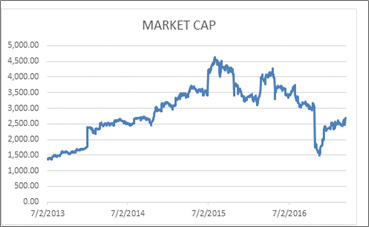
“The fracturing of trust is based on the fact that the customer has been let down.”
-Howard Schultz, CEO, Starbucks
 D+H’s announced sale last week to global tech investor Vista Equity Partners should be viewed as yet another “learning moment” for frustrated bankers. The vendor development and enhancement road map is the biggest lie in our industry, and thus banker trust of vendors has reached rock bottom at a time when technology ambitions have never been more important.
D+H’s announced sale last week to global tech investor Vista Equity Partners should be viewed as yet another “learning moment” for frustrated bankers. The vendor development and enhancement road map is the biggest lie in our industry, and thus banker trust of vendors has reached rock bottom at a time when technology ambitions have never been more important.
Vendors use product road maps and future enhancement lists to build a sense of optimism for bankers who are purchasing or renewing commitments to their solutions. It’s a delivery date promise meant to help bankers plan, but the fail rate on these promises is absurdly high. The stories that dug the chasm of mistrust between vendors and banks and credit unions are endless:
- Fiserv made customers listen to promises of an Acumen credit union core system and the future power of the Aperio BPM system.
- FIS promised IBS/Temenos “best of” product combination.
- JHA promised several solutions for retail front-end branch and loan systems and a NetTeller/goDough tandem digital banking solution.
- D+H (and before, Harland) promised integrated loan and core systems and specialized credit union functionality in the Phoenix EFE core.
- International players like iFlex, Infosys, SAP and Temenos promised robust U.S. banking functionality and are asking prospects to have faith in high-profile projects “in process.”
- All core vendors promised universal middleware with published integration kits and real-time CRM integration to platform, teller and loan origination modules.
None happened as planned, and most never materialized at all.
Vendor product road maps have devolved so badly that even sales reps don’t really expect their clients to believe them, nudge-nudge/wink-winking the crowd when they begin the road map PowerPoint assault. For banks evaluating vendor promises, the internal handicapping conversation goes something like this:
“OK, we have an announced general availability date of April 2017. We’ll be glad if it ever gets done, and we can probably bet on a 2020 actual go-live. We’ll be frickin’ elated if it happens in 2019.”
And everybody just laughs it off. The excuses for late or no product delivery roll off the vendors’ tongues like silk through a high-end loom:

“Well, the development project expanded as we beta tested, so we’re pushing out the dates so we can make this product even better.”

“New regulations sidetracked us.”

“Offshore development challenges … yada yada yada.”
Think about how far we’ve come: tired banks now just accept this BS like it’s part of doing business. The chasm of mistrust is deep. Not only do we not trust what the vendors are telling us about product releases, but we’d be recklessly naïve if we did.
Banks and credit unions collect when a loan is delinquent. They have a memo on the janitorial services CEO’s desk if the cleaning crew missed emptying a trash can last Wednesday. And woe the career of the delivery dude who showed up 15 minutes late with the bagels for the loan committee meeting. But technology vendors, which cash the biggest individual checks banks write, get a walk.
This dysfunction continues until someone with some steel cajones at the bank just decides they can’t work with a vendor anymore. Their trust is so eroded that they just decide to leave. It’s the single most common reason why banks and credit unions leave their tech providers. “Screw it; we’re outta here.”
When that trust gets broken enough times, vendors move into a death spiral of melting revenue and cost-cutting or lose their ability to stay independent. That just happened to D+H.
There are some truly top notch executives and awesome professionals at D+H, but D+H and Harland before that didn’t deliver on promises for so long that bankers’ trust in them vaporized. New prospects quit knocking on the door. Large clients quietly limped away. Smart, hard-working D+H talent hit the road for greener pastures, even if they didn’t yet know where to find that pasture. And once that starts – once no one including vendor employees buys the story even a little bit – it’s pretty much impossible for a vendor to recover.
When D+H announced it was up for sale and when it subsequently announced its sale to Vista Equity Partners, a total of no one was surprised. Vista plans to merge the former D+H with international treasury powerhouse (and core provider) Misys.
The best thing Vista can do is try to re-establish trust from former D+H customers, and combining it with an international player is not going to do that. It’ll end up a weird conglomeration of big bank and mid-size bank products with conflicting priorities. The twice-sold D+H customer base have no patience for long-term vision and hopeful synergy. D+H core customers’ trust has been way too low for way too long. No, they need real movement – now.
To build trust and probably make some money along the way, Vista should:
- Sell all the former D+H core platforms to a domestic entrepreneurial player that can breathe some life into these core products. The buyer might be an established core player, or it might be a lending competitor of D+H that wants a core anchor. The Phoenix EFE core has a Microsoft-based architecture with legs. With more than 100 solid community bank installs and a few large credit unions, it would be a shame to have it wither within a global financial corpocracy.
- Either double down on U.S. lending product investment and development or package the lending products and sell them to a domestic concern – maybe a core player that can consolidate and integrate a pretty wide array of lending products now at D+H.
- Keep Misys and D+H’s payments groups together with an eye toward large domestic and international banks, and be transparent about where the future sales focus and investment is really going to go.
Vista, with D+H you have a very irritated client base that is short on patience and long – really long – on frustration. Misys has earned a strong reputation as a FinTech provider with a wide international presence, but D+H customers at this point give zero damns about all that. No multi-colored technology stack diagrams or spin about synergistic opportunities will change the fact that the D+H customers now just see more layers and delays in fixing the problems they have complained about for so long. Corporate mergers and acquisitions do not speed up development and product enhancements; they always slow them down.
D+H customers cannot be the only parties upset at this point. The company’s formula of high-priced acquisitions juiced with debt followed by cost cutting has failed shareholders as well.

Source: SNL
D+H’s market cap was $1.3 billion the day before it announced the acquisition of Harland. D+H then spent $1.2 billion for Harland and another $1.3 billion for Fundtech. And then the company sold for $3.6 billion. I’m no investment banker, but I’m pretty sure that math doesn’t work for D+H shareholders. All the more reason to take the loan and core products as far away from the former D+H as possible.
Rebuilding Trust?
GonzoBankers, now is the time for D+H core and lending clients to pound the table and demand a short-term solution from Vista. Forget the synergy with an international pretty boy. It’s not going to materialize. Forget piggybacking on the Misys technology know-how. It won’t translate. No, you have to push Vista to get the products in the hands of a company or companies that have the energy, know-how and entrepreneurial upside to fix the problems with the D+H products. And it must be a company that can rebuild the gaping chasm of mistrust that has been left by D+H, a company with some great people that were not given the strategy and environment to succeed.
And bigger picture, Gonzos, we simply must break this cycle of just allowing ourselves to give the vendors a pass when it comes to development and enhancement promises. We’ve got to more formally and collectively track vendor development promises through a Vendor Performance Management program and raise holy hell when they are not met. By strengthening the currency of commitments from vendors, an environment can be created where the players who focus on development, innovation and customer support will beat those that focus on slick sales and financial engineering with an exit strategy. Our lives would be so much easier if we could bank on vendor development promises. We want to believe them so much that we even outwardly buy in when we know it’s impossible. This shared psychosis needs to stop.
The banking industry’s technology future is so dependent upon fewer and fewer vendors, we simply must hold the survivors accountable and make Vendor Performance Management as important as Asset Liability Management or Enterprise Risk Management. Sometimes that means leaving them, even when it would be very, very inconvenient to do so. Otherwise, GonzoBankers, the joke is on us.
Many thanks to Steve Williams and Sam Kilmer for their thoughts contributions to this article.